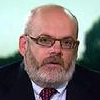Chicago Fed President Charles Evans on Wednesday said he wants to adjust monetary policy until it is giving the economy a slight boost. This means another quarter-point rate cut this year, he said, in a breakfast conversation with reporters.
But Evans said more accommodation could be needed, noting that it has been a very volatile week since the Federal Open Market Committee voted to cut interest rates by a quarter-point.
“We don’t know what the downside risks are,” he said.
Low inflation alone could justify another rate cut, Evans said. He said inflation as high as a 2.5% annual rate would not be a concern.
The FOMC will meet again in mid-September. The market is pricing in a 100% chance of a rate cut then and the chance of a 50-basis-point cut stands at 19%, according to CME Group data.
Evans, who is a voting member of the FOMC this year, said he still thinks the economy is in relatively good shape. He is forecasting a 2.25% growth rate this year.
Evans said that he might change his view on what the Fed needs to do if the labor market starts to weaken.
“The consumer is feeling good about the employment situation and being able to find a job. Anything that causes changes to those important fundamentals would be a concern,” he said.
Stepping back, Evans said that in 2018 he thought the goal of monetary policy was to get the benchmark interest rate about 50 basis points above 2.75% neutral rate. This year, he now sees the need to be 50 basis points below 2.75%.
“Basically adjusting from 50 [basis points] above neutral to something like 50 below neutral is sort of the mid-cycle adjustment I have in mind going forward here,” he said.
Last week, the Fed cut its benchmark rate to between 2%-2.25%. He said more accommodation could be needed because the “short-run” neutral level might be below 2.75%.
“We’re kind of looking at data, we’re kind-of looking to see to see how things are going to proceed, whether or not there is sort of an acceleration of something not very pleasant or whether or not we’ll have more continuity,” he said.
He said he didn’t think the Fed had reached the point where many academic studies suggest the best strategy for the Fed would be to aggressively cutting rates to avoid returning rates to near-zero levels.
Stocks have been lower all morning but have pared early losses. The Dow Jones Industrial DJIA, -0.32% as down slightly more than 300 points in mid-day trading.


